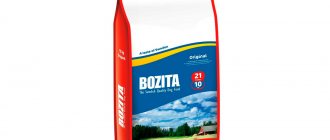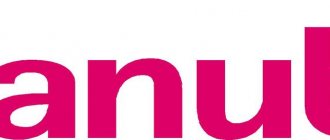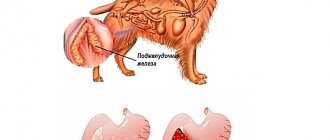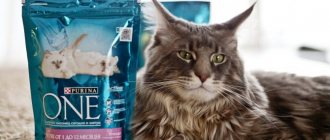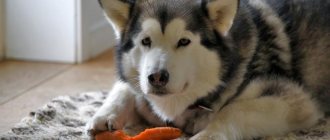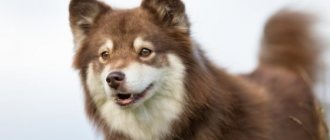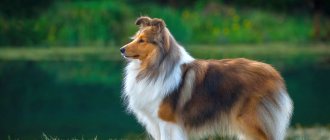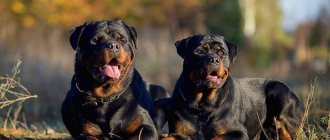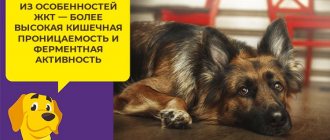Every owner must know the characteristics of the breed. The Chow Chow is an exotic guard dog with excellent coat, easy-going character, and strong bones. High exterior qualities, health and full longevity are what every dog lover dreams of. They are known to be omnivorous, love treats and gain weight quickly. In addition, dogs require skin, eye and coat care. From the article you will learn: how to choose food for chow-chow dogs, features of feeding puppies and adult dogs. And also, get a ready-made menu for the week and answers to the most popular questions on the topic.
Feeding dry food
For the owner, new food technology has made a big difference in pet feeding. You no longer need to stand at the stove, cook soups and main courses, or process vegetables.
At first glance, there seems to be no difference. They all look like granules, come in different packages, and don’t always smell pleasant. If it is canned, it is a type of pate or pieces in a sauce.
If we look at the composition, significant differences are found.
- Inexpensive food contains dyes, flavor enhancers, fragrances, and residues from the meat processing industry. Price list for 1 kg. does not reach more than 200 rubles.
- The middle class contains by-products and deboning residues at a more or less cheap price (up to 500 rubles). The manufacturer does not spare preservatives and sometimes enriches it with vitamins. Despite all the promises and widespread advertising, such food will never replace good nutrition.
- Expensive multi-component ones (price no less than 1,300 rubles) are a premium class that provides a complete diet. It is necessary to select, based on the characteristics of the breed, the pet’s lifestyle.
- Holistics contain only natural ingredients: lamb, turkey, vegetables, fruits. Preservatives - extracts from plants and vitamin E. They are considered the most expensive in price; their production is located in Canada, Italy, and the Netherlands. There is only one drawback: you can’t always buy it in a regular pet store, you have to make special orders.
Only the owner can choose what exactly the dog needs. Breeders and veterinary specialists will tell you the specifics.
Industrial feed
Nutrition based on industrial feeds also has advantages and disadvantages.
The advantages of such a diet include:
- ease of storage, use and dosing;
- balanced composition, taking into account the characteristics of the breed and enriched with all necessary vitamins, macro- and microelements;
- the ability to select food that takes into account the physiological characteristics of the pet;
- saving time on preparing food for the dog;
- long shelf life, allowing you to buy food for the animal for future use.
In addition, the special composition with which dry food granules are coated serves as a means of preventing the formation of plaque and tartar.
CAREFULLY!
The significant disadvantages of such a diet are that good food is quite expensive, and cheap products most likely contain low-quality meat or offal, as well as artificial colors, flavors and flavor enhancers.
You should also understand that if an allergic reaction occurs to one of the components of the food, you will need to completely change the chow chow's diet.
Industrial food includes not only dry food, but also wet food . They differ in that they contain up to 80% liquid, which makes them less nutritious, but more beneficial for the gastrointestinal tract of dogs.
The fact that products of different quality are used to make feed leads to the division of products into several classes:
- economy - the composition contains low-quality products, flavors, preservatives, flavor enhancers, dyes, there is a possibility of containing soy and beans;
- premium - the composition is based on meat, offal and vegetables, but it is unlikely that it contains vitamins and minerals;
- super-premium - only the highest quality products are used to make such food; it contains vitamins and all the necessary macro- and microelements.
In addition, almost all brands have a line of holistic foods, the composition of which is as close as possible to the natural diet.
It is also possible to choose hypoallergenic food, food for dogs with sensitive digestion, pregnant and lactating bitches, and elderly animals.
Economy class
They have low nutritional value. Large portions will be required to satisfy you.
Pedigree
Darling
Oscar
Stout
Chappie
Friskez
Caesar
Our brand
Premium class
Royal Canin
Probalance
Hills
Super premium
The product descriptions in the annotations will help you decide on the composition that is most suitable for your pet.
Fest Choice
Trainer
Arden Grange
Gina Elite
Porclean
Brit Care
Daily Dog
What food is good for chow-chow dogs?
It is very important to organize the diet so that for a puppy or an adult Chow Chow there is enough food enriched with all the necessary nutrients. After all, it is important not only to formulate the diet correctly, but also to follow a certain feeding regime.
It is equally important to determine the optimal amount of food for one meal. This is not difficult to do: pour in a portion of dry food or natural food and watch the dog.
If all the food is not eaten within 20 minutes, then the portion needs to be made smaller.
If a puppy or adult dog ate everything in 5 minutes and continues to stand at the bowl with a questioning look, this indicates the need to increase the amount of food consumed by the dog at one time.
You should also rely on the rate of weight gain. Keep an eye on this point, as this breed has an uncontrollable appetite. The dog should not be hungry, but it is equally important to control that he does not overeat.
Puppy
When choosing food for Chow Chow puppies, you should pay attention to its class. Premium and super premium are two suitable options if you choose store-bought wet or dry food for feeding.
The daily norm is approximately 70 g per kg of puppy weight. The number of feedings per day depends on the age of the pet.
A puppy of this breed requires 6 meals a day in the first two months of life. After 2 months, transfer your pet to 5 meals a day. When he reaches 4 months of age, start feeding him 4 times a day.
After reaching six months, the dog must be switched to 3 meals a day.
Similar article: How to choose and name a Chow Chow puppy beautifully
Adult dog
When the dog becomes an adult (reaches the age of 10 months), it is transferred to two or three meals a day. The schedule is selected individually depending on the capabilities of the owner. Divide the daily allowance into two or three equal parts and give it out at regular intervals.
It is better for an adult Chow Chow to receive food at exactly the same time every day. If you feed natural products (porridge with meat, fruit, etc.), store the food in the refrigerator and warm it up slightly before feeding.
Natural nutrition
If you prefer to feed your pet natural food, at a very young age you can try giving him minced meat along with mother’s milk. When a puppy moves to a new home, he experiences stress. To alleviate his condition, do not change his feeding regimen. Stick to the same schedule as the breeder had.
What to feed a chow chow if you choose “natural”? The optimal foods for this breed are as follows:
- meat. Only low-fat varieties. It could be beef or poultry;
- offal. This includes the liver, lungs, stomach, heart. Only 15% of the daily meat intake can be replaced with offal;
- dairy products. You can give your dog natural yogurt without additives, kefir, yogurt, cottage cheese, milk;
- cereals. Prepare porridge for your pet from barley, wheat, and buckwheat. You can also give boiled rice;
- vegetables. An integral part of the chow chow diet. Feed your pet sweet peppers, cucumbers, cabbage (but not raw). You can add a small amount of beets to dishes;
- fruits. It is allowed to give apples, bananas (in small quantities), berries, pears.
If you feed lean pork, it must first be thoroughly boiled or placed in the freezer to kill parasites.
Remember that chow chow dog food should not contain potatoes, legumes, or corn. You should not give your dog pasta. Fatty meat is also contraindicated for such dogs. Processed meat in the form of sausages and sausages should also be excluded from the diet.
Do not give your pet smoked meats, salty foods, or canned vegetables - all these products are harmful to the animal and will not bring any benefit to the animal’s body. Chocolate is also prohibited. Even if a puppy or adult dog really asks, do not give sweets.
Related article: How to keep and care for a Chow Chow dog
Dry food
Dry food is the optimal solution for those owners who lead an active lifestyle and do not have enough time to regularly prepare food for their pet. Chow chows should be fed only with high-quality feed. Give preference to well-known manufacturers. Eukanuba, Purina Pro Plan, Hill's, Nutra, Pronature foods have proven themselves well.
When you choose a specific type of “drying”, do not buy a lot at once. There is a risk that the dog will have an allergic reaction or that he simply will not like the food. In this case, you will have to replace it with another brand or another variety from the same manufacturer.
Before purchasing, be sure to study the composition. It should not contain preservatives, dyes, or flavor enhancers. The granules must have a uniform structure and color. Evaluate the smell: high-quality chow chow food has a mild, neutral odor.
When giving this food to your puppy, first place the portion in a bowl and fill it with hot water. Leave for 7 minutes. The granules should be saturated with water and soften. This must be done so that the puppy does not damage young teeth that are not yet strong.
An adult chow chow is fed dry food in solid form.
Useful vitamins and nutrition
For normal bone formation, it is necessary to give the puppy additional mineral supplements. This is extremely important in the first year of a pet's life.
To maintain health and normal coat condition, give your dog high-quality supplements. These can be supplements and vitamin complexes “Slicks”, “Sanal”, “Farmavit”, “Biocefit”.
“Fitocalcevit” is suitable for the normal development of the whole organism.
Video “All about the Chow Chow breed”
In this video you will learn how to care for and train this funny Chow Chow breed.
Holistic
All the necessary elements have been selected, the owner does not have to come up with a replacement. Among holistic practitioners, the leading places are occupied by:
Grendorf
Akana
NauFresh
Features of feeding chow chow puppies
From the age of 2 months, small dogs are gradually accustomed to a diet. You need to start with 5 meals a day, gradually moving to 2 meals a day by the age of 12 months. If puppies are prone to damaging things, then pay attention to the lack of vitamins. The newspaper will help you wean yourself from a bad habit. Rustle or pat near the ear.
It is advisable to gradually wean the puppy from its mother's milk. It is better to give fermented milk products. Porridges made from egg, rice, and buckwheat help you quickly gain weight and get stronger. Apples, pears or bananas, and raspberries are suitable as sources of vitamins. Feedback or recommendations from experienced “dog lovers” will help you decide.
As they grow older, the portions increase and they are allowed to switch to dry food. A small chow chow cannot chew it or digest it, so it must be mixed with water.
Basic Needs
The dog can be fed both dry food and natural food. Regardless of what type of feeding is chosen, the food should cover the basic needs of the pet. It is important to understand that the needs of a puppy, an adult and an older dog are different.
A puppy's needs change very quickly as they grow and develop. Up to 4 weeks, the puppy receives all the necessary components with mother’s milk (easily digestible proteins, fats, carbohydrates, immunoglobulins, local protective factors).
As it grows, mother's milk becomes insufficient, and the needs of a small dog increase. Therefore, from 1 month you need to introduce an additional source of nutrients - complementary foods. For this, boiled chicken meat, vegetable purees, and cottage cheese are used. The food used for complementary feeding should be warm, sufficiently crushed, and hypoallergenic.
After reaching 3 months of age, the dog is transferred to a full diet, without mother's milk.
Adult dog
An adult dog needs a daily supply of the following components:
- Squirrels. Proteins are a building component, responsible for muscle strength and tone, heart contractions, and the immune system (antibodies are proteins by nature). The diet must include proteins of animal origin so that the pet can receive all the essential amino acids.
- Fats. Chow chow needs both animal and vegetable fats. Fats provide the dog with a shiny and beautiful coat, normal hormonal levels, and healthy skin.
- Carbohydrates. Carbohydrates are a source of energy; they provide any activity for your pet. You need to include slow and fast carbohydrates in your diet.
- Vitamins. They take part in almost all processes in the body. Pets can receive vitamins from food or in the form of additional supplements.
- Microelements. A normal intake of potassium, magnesium, zinc is required, and in old age - calcium and phosphorus.
We invite you to familiarize yourself with: The quietest compressor for an aquarium. DIY silent compressor for an aquarium
What to feed an adult dog?
A variety of tastes and variations in nutrition allow you to preserve your pet’s youth for a long time. As you grow older, your diet gradually expands to include:
- vegetable fats: olive, sunflower, flaxseed oil;
- carbohydrates in the form of cereals (oats, buckwheat, rice are allowed), dried rye flour bread;
- vitamins, minerals: fruits, vegetables, additives, cereals;
- proteins (beef, chicken breast, turkey), sea fish, eggs;
- fermented milk products, cheeses.
The feeding dosage is calculated based on the fact that the dog should eat no more than 2-3% of its weight per day.
How to feed a puppy correctly?
The table shows the approximate diet of Chow Chow puppies by month.
| Age | Approximate diet | Number of feedings |
| 1-2 months | 100-200 g finely chopped beef, 50-100 g calcined cottage cheese, 100 g milk porridge, 1 tsp. fructose, 1 yolk, 60-100 g kefir, 50-100 g porridge in meat broth, 50 g vegetables | 6 |
| 2-3 months | 200-300 g of meat, 100 g of calcined cottage cheese, 100-200 g of porridge in broth, 100 g of kefir, 100 g of vegetables and herbs, 1 yolk | 5 |
| 4-5 months | 300-400 g of meat, 200 g of porridge in broth, 200 g of calcined cottage cheese, 200 g of kefir or fermented baked milk, 200 g of vegetables | 4 |
| 5-6 months | 500 g meat, 200-300 g porridge in broth, 200-300 g cottage cheese, 200 g kefir or fermented baked milk, 200 g vegetables, 400-500 g fish, 2-3 g brewer's yeast | 4 |
| 6-10 months | 400 g meat, 200 g porridge in broth, 200 g cottage cheese, 200 g kefir or fermented baked milk, 200 g vegetables, 400-500 g fish, 2-3 g brewer's yeast | 3 |
Menu for the week
Chow-chows are considered “gluttons” among dog breeders. For many of them, food is the meaning of life. The table shows a sample menu for the week.
| Day | Breakfast | Dinner |
| Monday | Meat+cereals+vegetables | Chicken+rice |
| Tuesday | Cottage cheese+egg | Meat+cereals+vegetables |
| Wednesday | By-products+vegetables | Cottage cheese+egg |
| Thursday | Fish+rice | Meat+cereals+vegetables |
| Friday | Chicken+rice | By-products+vegetables |
| Saturday | Cottage cheese+egg | Chicken+rice |
| Sunday | By-products+vegetables | Meat+cereals+vegetables |
Natural food or artificial food?
Like dogs of other breeds, Chow Chows can be fed both natural products and industrial food. Each type of nutrition has pros and cons, so it is impossible to definitively answer which one is better.
- Choosing a pet’s diet is the owner’s responsibility.
- The only thing we can say with certainty is that when composing a diet, it is necessary to monitor its balance and take into account the dog’s age, health status and level of physical activity.
- A natural menu allows the owner to independently control the quality and freshness of the food consumed by the pet, however, it takes quite a lot of time to prepare food.
- In turn, industrial food is sold ready-made and has a balanced composition that takes into account the needs of the dog, which greatly facilitates the task of its owner.
- You cannot mix both types of food, since the animal’s body produces different enzymes to process natural products and feed..
A natural diet has many advantages: it does not contain chemical flavorings or taste enhancers, nutrients of natural origin are better absorbed by the animal’s body, and such nutrition will cost the owner much less than industrial feed.
However, many dog breeders believe that with a natural diet, a dog can be given almost anything, including leftovers from the common table. This opinion is wrong and can lead to serious health problems for your pet.
Most breeders prefer to feed dogs with ready-made food because it is more convenient, easier and faster, and the likelihood of negative consequences if high-quality products are used is extremely low.
Pros and cons of natural food
In addition to the fact that with this type of feeding the owner has the opportunity to independently choose only high-quality and fresh products for the pet, a natural diet has a number of other significant advantages:
- the absence of chemical flavors, dyes and taste enhancers, which not only do not benefit the animal, but can also harm it;
- if an allergic reaction occurs to one of the products, it can be excluded from the menu without changing the dog’s diet as a whole;
- vitamins and minerals necessary for the health and development of your pet are of natural origin and are better absorbed.
A significant advantage is the opportunity to save on feeding your pet by purchasing seasonal vegetables and fruits and alternating beef or veal with chicken.
Disadvantages of this type of nutrition:
- it is impossible to create a balanced diet without certain knowledge of veterinary nutrition;
- Your pet needs to cook every day - stale food does not retain useful components, and it can also cause poisoning or other problems with the gastrointestinal tract;
- cooking takes quite a long time;
- For people who often travel with a pet, such a diet presents additional difficulties and inconveniences.
With a natural diet, it is necessary to take a vitamin-mineral complex.
Authorized Products
Representatives of this breed must include in their menu:
- lean meats;
- offal;
- fermented milk products with low fat content;
- cereals;
- vegetables;
- fruits;
- greenery;
- boiled chicken eggs;
- sea and ocean lean fish.
As a treat or reward during training, you can give your pet some nuts or hard cheese, and to prevent the formation of plaque and tartar - raw beef bones.
What is prohibited
You can't give chow chow:
- potato;
- legumes;
- corn;
- pasta;
- pearl barley, corn, barley;
- candies, chocolate and other sweets;
- salo;
- smoked meats, canned food, sausages;
- river fish;
- pollock;
- capelin;
- fat meat;
- tubular bones;
- semi-finished products;
- pickles, marinades;
- yeast baked goods;
- exotic fruits and berries.
Adult dogs should not be given milk due to lactose intolerance.
Sample menu for the week
| Days of the week | Product Set |
| Monday | 300 g cottage cheese, 400 g beef, 100 g vegetables with rice porridge |
| Tuesday | 1 egg, 300 ml natural yogurt, 100 g buckwheat porridge with vegetables, 500 g fish |
| Wednesday | 300 ml kefir, 340 g veal, 60 g offal, 100 g wheat porridge with vegetables |
| Thursday | 300 g cottage cheese, 400 g turkey, 100 g vegetables with buckwheat porridge |
| Friday | 1 egg, 300 g cottage cheese, 340 g beef, 60 g offal, 100 g vegetables with rice |
| Saturday | 300 ml natural yogurt, 500 g fish, 100 g vegetables with buckwheat |
| Sunday | 300 g cottage cheese, 400 g veal, 100 g vegetables |
You should also give your chow chow vegetable oils, but not more than 1 tbsp. l. per day .
Industrial feed
Nutrition based on industrial feeds also has advantages and disadvantages.
The advantages of such a diet include:
- ease of storage, use and dosing;
- balanced composition, taking into account the characteristics of the breed and enriched with all necessary vitamins, macro- and microelements;
- the ability to select food that takes into account the physiological characteristics of the pet;
- saving time on preparing food for the dog;
- long shelf life, allowing you to buy food for the animal for future use.
In addition, the special composition with which dry food granules are coated serves as a means of preventing the formation of plaque and tartar.
You should also understand that if an allergic reaction occurs to one of the components of the food, you will need to completely change the chow chow's diet.
Industrial food includes not only dry food, but also wet food . They differ in that they contain up to 80% liquid, which makes them less nutritious, but more beneficial for the gastrointestinal tract of dogs.
The fact that products of different quality are used to make feed leads to the division of products into several classes:
- economy - the composition contains low-quality products, flavors, preservatives, flavor enhancers, dyes, there is a possibility of containing soy and beans;
- premium - the composition is based on meat, offal and vegetables, but it is unlikely that it contains vitamins and minerals;
- super-premium - only the highest quality products are used to make such food; it contains vitamins and all the necessary macro- and microelements.
In addition, almost all brands have a line of holistic foods, the composition of which is as close as possible to the natural diet.
It is also possible to choose hypoallergenic food, food for dogs with sensitive digestion, pregnant and lactating bitches, and elderly animals.
Top 7 rating
Only high-quality products, not lower than premium, and preferably super-premium or holistic food, are suitable for feeding chow chows.
Most popular foods:
- Brit . Super premium food. Contains lamb meat and rice. Contains vitamins, herbal extracts and chondroprotectors to prevent joint problems.
- Now . Super premium products. The composition is based on hypoallergenic turkey meat, instead of cereal porridge it contains dried vegetables and fruits, and is also enriched with vitamins and lactobacilli.
- Belcando . German-made canned food, the main component of which is turkey meat. The gravy contains rice and vegetables. In addition to the standard set of vitamins, canned food also contains calcium, fluoride, and lecithin.
- Acana . They contain natural meat and fresh vegetables, and the food lines intended for large breeds of dogs contain almost no carbohydrates.
- Purina ProPlan - despite the fact that the food belongs to the premium category, it contains flavorings and taste enhancers that can provoke an allergic reaction.
- Nutram is a high-quality food made from selected natural products with quality certificates.
- Happy Dog has both premium and economy class food, so it is important to carefully study the composition. The advantage of Happy Dog food is that at a fairly low cost, many lines are not inferior in quality to food brands such as Hills or ProBalance.
Dry food should be given to adult dogs in solid form, while puppies should be soaked in water or milk.
How to feed a puppy correctly?
The table shows the approximate diet of Chow Chow puppies by month.
| Age | Approximate diet | Number of feedings |
| 1-2 months | 100-200 g finely chopped beef, 50-100 g calcined cottage cheese, 100 g milk porridge, 1 tsp. fructose, 1 yolk, 60-100 g kefir, 50-100 g porridge in meat broth, 50 g vegetables | 6 |
| 2-3 months | 200-300 g of meat, 100 g of calcined cottage cheese, 100-200 g of porridge in broth, 100 g of kefir, 100 g of vegetables and herbs, 1 yolk | 5 |
| 4-5 months | 300-400 g of meat, 200 g of porridge in broth, 200 g of calcined cottage cheese, 200 g of kefir or fermented baked milk, 200 g of vegetables | 4 |
| 5-6 months | 500 g meat, 200-300 g porridge in broth, 200-300 g cottage cheese, 200 g kefir or fermented baked milk, 200 g vegetables, 400-500 g fish, 2-3 g brewer's yeast | 4 |
| 6-10 months | 400 g meat, 200 g porridge in broth, 200 g cottage cheese, 200 g kefir or fermented baked milk, 200 g vegetables, 400-500 g fish, 2-3 g brewer's yeast | 3 |
Combined nutrition
If diseases are detected, the doctor will consider it necessary to recommend the use of a combination diet.
There are rules that will allow you to avoid an overabundance of any substances.
- Do not mix dry and natural food in the same bowl.
- Choose a mode when the animal will receive “drying”, for example, in the morning. Always give “straight” in the evening.
- Despite the high quality of the holistic, super-premium type, it is not advisable to soak them with water. Thus, you are deceiving yourself, not the dog, thinking that it will be more natural.
If you cook it yourself, then calculate the calorie content and add vitamins.
Natural nutrition
The puppy tries adult food while being close to its mother. Usually, at 2 months, babies willingly drink milk and even chew minced meat. If the breeder adheres to industrial nutrition, the puppies receive wet food (pates). At 3 months, the baby moves to a new home, which is associated with severe stress. To facilitate adaptation, the pet’s diet and daily routine do not change for 7–10 days. Afterwards, the Chow Chow's nutrition is completely under the control of the new owner. If you choose “natural”, the ward’s menu expands to the following set of products:
- Meat (beef, less often poultry without skin and bones).
- By-products (10–15% of meat can be replaced) – heart, stomach (rumen), liver, lungs, trachea, cartilage.
- Milk and dairy products - homemade yogurt, kefir, yogurt, cottage cheese (preferably calcined).
- Eggs – several per week, only boiled for puppies.
- Cereals – wheat, barley, rice, buckwheat. Barley is indicated for dogs that quickly gain weight. Corn grits are neither harmful nor beneficial.
- Vegetables - sweet peppers, tomatoes, cucumbers, zucchini, radishes, cabbage (not raw), carrots, beets (not a lot).
- Fruits - apples, pears, some bananas, berries, nuts.
Whether an adult Chow Chow should be fed dairy products or pork is up to you to decide. Let us only point out the fact that fatty meat is contraindicated for dogs, and lean pork must be boiled or deep-frozen (it may contain the false rabies virus).
Lactose intolerance is not a fiction, but in fact, this trait is characteristic of some (not all) dogs. If your pet begins to have diarrhea after a bowl of milk, it is most likely worth switching your pet to fermented milk products.
Vitamin and mineral supplements
Comprehensive nutrition for a dog of this breed is impossible without adding minerals and vitamins to the food. Despite the promise of high-quality food manufacturers that all components are in abundance, the owner must use additional options.
The following components are used: calcium gluconate; complexes with glucosamines, chondroitins; multivitamins; omega-3 complexes. For a puppy, it is necessary to control the content of vitamins A and D.
Chow Chow: dog character, behavior
In general, it is not easy to talk about the Chow Chow, the description of the breed, the character of the dog, since each dog is a bright individual. But we will try to combine some common features characteristic of this amazing breed.
It is believed that a chow is capable of obeying only one owner; the rest of the family will simply be his brothers with whom you can walk, eat from their hands, nothing more. Therefore, only one person in the family is involved in his upbringing and training. When a puppy appears in the house, it is important to immediately let him understand that the person sets the rules in his “pack” and he is in charge here. Otherwise, the dog may become too uncontrollable.
Alert, curious, noticing everything, the Chow Chow has his own opinion about everything, even lying down, resting, he watches people, analyzes, and draws his own conclusions. This brave dog never becomes timid in extreme situations, when real danger arises.
If you find an approach to this independent animal, reach mutual understanding, and treat it with the utmost respect, the chow will obey its owner and bring joy to all family members. Kind in the family, affectionate to the owner, the Chow Chow will willingly and patiently play with children if they do not hurt him or disturb his living space.
The most important character traits are independence and restraint, selfishness and natural spoilage. This is a telepathic dog, a philosophical dog. The character depends on the gender of the Chow:
- bitches are more cunning and flexible, it is extremely difficult to anger them, but
- Males may get into fights with other males or be aggressive towards street cats.
Behavior at home
At home, the dog behaves respectably, walks quietly, hardly barks, does not damage things or furniture, and most often lies down and rests. Puppies relieve themselves strictly in a certain place, usually on a newspaper or rag (where it smells like urine), and quickly learn to show that they need a walk. Even when a puppy is brought into the house for the first time, he chooses a place for himself (comfortable, well-ventilated, secluded, fairly closed), it is not possible to force and accustom him to a specific place at the owner’s request, and the chow does not need bedding or a bed.
Behavior on the street
On the street, the Chow Chow avoids all puddles and mud; if it is damp and raining, it steps carefully, afraid of getting wet, and may even refuse a long walk (it will relieve itself in 5 minutes and show that it wants to go home). He never goes to the toilet in the most visible place, but hides in a corner or along a fence, on a pile of garbage or in an unkempt dirty place, realizing that he will not spoil it too much by doing his job. Chaushkas are picky eaters, so they do not pick up various edibles (food, bones) on the street.
In the period of 3-7 months, puppies may exhibit such an interesting genetic instinct of a hunter, when the puppy tries to get rid of its own smell so as not to scare away the game. When a strong-smelling substance is discovered on the street (usually manure, rotten food), the chow-chow’s behavior becomes strange, the puppy falls on its back, rubs itself and tumbles, trying to get as dirty as possible in something that smells strongly. If this happens, you just need to get over it, you shouldn’t scold the poor guy too much, it’s a natural instinct, fortunately, it goes away with age.
Other dog breeds have an extremely negative attitude towards Chow males. A chance meeting of a male Chow on the street with any other male can lead to a fight. Moreover, the instigator of the conflict, as a rule, is a representative of another breed; the Chow only responds to aggression with aggression.
Chow chows, for obvious reasons, do not tolerate heat well and feel good in winter, they love snow, they can lie down in a snowdrift to rest or roll out in the snow. In regions with hot summers, you should choose a cool place for them, without drafts.
Attitude towards strangers, protection of the owner and home
The attitude towards strangers is extremely distrustful, the dog avoids the affection of a stranger and looks at him appraisingly, and may even growl. When a bell rings or knocks, he will rush to the door with a growl or bark, and only if the owner makes it clear that the guest is welcome and treats him well, the dog will watch him and, after sniffing, form his own opinion and remain wary. Like a shepherd dog, a chow cannot be trained to guard, it is an instinct - he will protect and protect only out of love, and not out of duty.
Feeding a pregnant chow chow
During pregnancy, to ensure full gestation and to avoid complications during childbirth, nutrition becomes more complete.
| Weeks of pregnancy, lactation | How many times a day should I feed? | Diet: features and exceptions |
| from 1 to 4 | no more than 3 | Introducing fermented milk products, cottage cheese to increase the proportion of calcium, fish products |
| From 5 to 8 | No more than 4 | Add vegetables, fruits, vitamins B, A, E, D |
| From 8 weeks until birth | from 5 to 6 | Remove bone products from the diet, combine fish with meat (boil, do not salt) |
| 1 week after birth | 5 | Completely exclude sour milk and fish. Increase nutrition with milk and proteins |
| 2 weeks until the end of lactation | until 3 | Increase the amount of calcium, vitamins |
Chow Chow's preferred diet
When purchasing a four-legged friend for your home, you need to understand that this is a huge amount of work.
After all, it is not only necessary to play with an animal, educate it, but also feed it properly. By choosing the wrong feeding tactics, you can end up with a sick animal that will not bring joy to the owners, but will only torment you with its constant illnesses. Each dog breed is individual, therefore, when choosing a chow chow, you should take into account all the subtleties of the diet. This dog is a representative of large breeds, therefore, more food will be needed than for small animals. Considering that nutritious food is not cheap, you should estimate the family budget to see whether it can withstand the additional load. When buying food in packs, you should not mix it with regular food left over from a family meal. Goodies from the owner's table can harm the family pet. Every dog should have clean water at all times. A bowl of water is placed in a place where the animal can find and drink it at any time of the day or night. If it is not possible to prepare food for your pet at home or you have to go somewhere, and the road is long and the dog needs to be fed, then ready-made food or canned food will come to the rescue. When choosing dry food as the main food for your pet, you should not save money. Cheap food is made with the addition of grains (bran, rice flour). Economy class food contains many ingredients that are not only useless for the animal, but can also harm it. Specialized pet stores offer a wide range of ready-made food for pets to choose from. Before you buy any food, carefully read what is written on the label. If the meat content does not exceed 70%, then this is food that will not meet the pet’s needs. The Chow Chow dog breed is very picky about food, and allergic reactions are also common among them. When purchasing food, pay attention to premium types. Only they will help maintain the normal physical condition of the dog, even if you feed them constantly. A puppy and rules for feeding it A dog up to 4 months of age is fed at least 4 times a day. The puppy must learn that the uneaten treat is put away and he will receive the next one strictly on schedule. This way the correct diet will be established. After 4 months, the patient is transferred to feeding twice a day. The puppy needs to buy fresh meat or fish, which will be ground before feeding. Milk porridge (rice, oatmeal flakes) will allow you to diversify your diet. Not only milk is added to porridge, it can be replaced with vegetable oil, preferably olive oil. Cod liver is considered a very healthy food. It contains a lot of elements that are beneficial for puppy health. Dairy products should also be included in the diet. Cottage cheese, milk, kefir, yogurt - everything you can offer your four-legged friend. These products are tasty and healthy because they contain large amounts of calcium. Eggs are included in a dog’s diet without fail. A young chow-chow dog, what to feed. A dog can be considered an adult after the one-year mark. The feeding principle is being revised, and the pet is fed once a day. Nature created dogs as predators. Their main food is prey. Therefore, meat dishes should make up a larger percentage than other dishes. The stomach of the Chow Chow is very delicate. Representatives of this particular breed often suffer from food allergies. An adult pet is fed once a day in the evening. At one time, 250 grams of beef or poultry are allocated. It is not recommended to feed chicken and pork. A side dish in the form of boiled porridge or soup is added to the meat. They are prepared with the addition of butter and fresh vegetables. Among vegetables, chow chows prefer zucchini, carrots, tomatoes, cucumbers, cabbage, and pumpkin. From berries and fruits - apples, raspberries, grapes. Before giving vegetables, boil them a little, this reduces the level of nitrates. Bones help train the jaws and clean teeth. But not all bones can be given to your pet. Tubular (chicken) ones, when chewed, produce very sharp fragments that can injure the stomach or even pierce it. They are prohibited from being given to dogs of any breed. Beef bones are the best option for cleaning the jaws of a young dog. Sea fish is included in the menu at least 2 times a week. Squids are acceptable in the diet, but are not required products. But cottage cheese, kefir, and sour cream should be included in the weekly diet several times. Dried fruits, and especially raisins, will become a favorite treat, for which the dog will follow commands. Candy and other sweets should not be given to dogs. They do not benefit the body, but only add to the disease. An animal of advanced age and its diet Older individuals need careful attention to their health. Since childhood, their stomach is very delicate, which means that in old age they should adhere to dietary nutrition. Give more vegetables and fruits. Meat and fish should be boiled and finely ground. At any age, you should not feed your dog fried foods or offer smoked meats. Pickles and food with pepper should not enter the dog’s stomach. And do not give sweets - they are very harmful to health. Article provided by the organization “Veterinary hospital at home” vet-aib.ru
Nutrition for health problems
Dietary food for dogs, regardless of age and size, is similar to what is prescribed for humans. If you prepare food yourself from natural products, then it is advisable to use steaming and simmering methods. The list of unwanted components includes:
- raw vegetables, root vegetables due to starchy substances;
- sweet fruits due to their fructose and glucose content;
- high content of animal protein, which causes intestinal problems.
Dietary nutrition provides a fractional approach. If before the Chow Chow's illness feeding occurred 2 times a day, now food intake is divided into 5-6 meals.
Rating of food for chow chow
Before writing the rating, consultations were held with veterinarians and feedback from owners of the Chow Chow breed was taken into account. This data helped compile a list of the best balanced and affordable diets. For their production, only fresh, high-quality products and proven technologies were used.
To determine the winners, the following characteristics were analyzed:
- Type of food – dry or wet;
- Class – economy, premium or super-premium;
- Animal age – for puppies, adults or seniors;
- Breed size – for small, medium or large;
- The ratio of proteins, fats and carbohydrates;
- Number of vegetables, berries, fruits and plants;
- Presence of harmful components;
- Therapeutic effect;
- Size, shape and smell of granules;
- Versatility;
- Degree of digestibility;
- Shelf life and consumption;
- Weight and type of packaging;
- Availability of zip lock.
Even during the selection, attention was paid to the absence of allergic reactions and addiction, as well as the price-quality ratio. Initially, more than 20 nominees took part in the testing. After careful study, only 7 winners were included in the TOP.
What should you not feed?
The breed is prone to allergies. There is a list of products that are strictly prohibited for consumption.
- Bones with a tubular structure. An adult dog will quickly deal with them. When chewed, the bones break into fragments, which injure the oral cavity and digestive tract.
- Fatty foods, which causes a risk of increased cholesterol and gastrointestinal problems.
- Smoked meats, sausages due to spices, flavor enhancers. It’s easy to spoil your pet with “goodies.” Behind this lies a refusal to eat a normal diet.
- Baked goods, pasta, legumes, semolina, potatoes due to the high content of starchy substances that complicate the digestion process.
- Sugar, sweeteners, chocolate. This is a potential path to excess weight and diabetes.
What is prohibited from giving chow chow
These dogs are strictly prohibited from giving the following:
- tubular bones (especially chicken), broths cooked on bones;
- pork meat in any variety;
- legume products;
- all types of pasta;
- potatoes - as an exception, you can give your pet just a little raw tuber, but such feeding should not be too frequent;
- any types of sweets - dogs do not tolerate sugar well, which causes them to develop liver and pancreas damage and diabetes;
- spoiled food - it is a mistaken opinion that dogs can be given what a person has not eaten - this causes them to develop severe diseases of the digestive tract and poisoning;
- everything fatty and smoked - such dishes have a negative effect on the liver;
- sausages, including frankfurters.
It is forbidden to give excessively cold or hot food.
Owner reviews
Igor, 35 years old
My Sezan is already 7 years old, a respectable age. Three years ago I started having problems with my kidneys. Traces of protein were found in the blood, and he had difficulty urinating. The doctor made a disappointing diagnosis of urolithiasis. Now we have switched to three meals a day, which I prepare myself. I boil the lungs and liver, mix them with oatmeal and millet porridges, add carrots. We check it every year and so far everything is fine.
Lyudmila, 42 years old
I have been the owner of Persia for 4 years. As soon as we purchased the puppy from the breeders, we were recommended dry food. In fact, it turned out that it is not as complete as they promised. I had to change to another one. There was gas, poor health, refusal to take long walks. Despite the fact that I did everything according to the recommendations, it is difficult to change food. Therefore, it is better to immediately focus on a good and expensive product.
Wet food for chow chow
The technology for producing wet mixtures consists of grinding, mixing and extrusion. The last stage involves the use of lower pressure and temperature than in the manufacture of dry food. This allows you to save most of the vitamins. The Vyborexperta.ru team conducted a comparative analysis of the characteristics of 10 nominees. The 3 winners will have the most nutritional value for chow chow.
Brit
Premium Czech-made food designed for adult dogs (from 1 to 6 years) of all sizes. It has an optimal ratio of proteins, fats and carbohydrates and is 100% hypoallergenic, therefore suitable for pets with diseases of the gastrointestinal tract.
The meat component is represented by beef and offal (lung, abomasum, trachea, etc.), which are ideally combined with rice cereals. Additional ingredients include carrots, vegetable oil, gelling agent, minerals, vitamins, salt and water.
Wet diets are characterized by high nutritional value, which is important for a full, active life for a pet. Its components improve brain function, have a positive effect on the immune system, the health of bones and joints, and the beauty of the coat. Brit can be used either in its pure form or mixed with cereals.
Advantages:
- Does not contain flavor enhancers, preservatives or soy;
- Affordable price;
- Smells good;
- Dogs eat with great pleasure;
- Large jar volume – 850 g.
Flaws:
- Viscous consistency.
Before serving, it is advisable to bring chow chow dog food to room temperature, which will improve its digestibility.
Four-legged Gourmet Golden Line
…For a long time I couldn’t find the optimal diet for my two-year-old chow-chow. There were problems with the quality of the wool, an allergic reaction appeared. The four-legged Gourmand Golden Line helped get rid of these problems. My pet feels great and looks beautiful...
Expert opinion
Canned food does not contain GMOs, flavor enhancers, soy and preservatives. The diet is suitable for a strict or mono-protein diet for dogs, as it consists of 98% natural turkey meat without skin.
They are low in calories and have a high content of minerals (magnesium, iron, potassium, selenium, etc.) and vitamins (K, PP, D, A, E, etc.).
The four-legged Gourmet Golden Line replenishes energy resources, has a beneficial effect on the functioning of the cardiovascular and nervous systems, prevents anemia, reduces cholesterol, and improves the condition of the skin and coat.
To prevent fluid accumulation, a gelling additive of natural origin is used. Canned food is designed for all breeds aged 1 to 6 years. They can be used for daily feeding and as a supplementary diet.
Advantages:
- Not addictive;
- Optimal energy value – 155 kcal per 100 g;
- Suitable for even the most demanding dogs;
- Can be used for pregnant and lactating women;
- Value for money.
Flaws:
- Not detected.
Hill's Prescription Diet for gastrointestinal diseases
Medicinal canned food is prescribed for pancreatitis, colitis, gastroenteritis, diarrhea and coprostasis. They restore the body after surgery and help with impaired exocrine pancreatic function.
Hill's Prescription Diet contains easily digestible proteins and fats in the form of turkey, pork, rice, eggs, flaxseed and soybean oil. All this has a positive effect on nutrient absorption and tissue regeneration. The balanced composition replenishes energy needs, saturates cells with oxygen and reduces inflammation.
Additional ingredients include corn, ginger root, and rice flour. To maintain healthy intestinal microflora, chow chow dog food uses natural fiber (cellulose and sugar beet pulp). The food is designed for dogs of all sizes.
Advantages:
- Clinically proven effectiveness;
- Excellent taste;
- Optimal consistency;
- Reduced amount of fat (3.8%);
- No flavors, artificial preservatives or colors.
Flaws:
- Somewhat high price.
To avoid negative reactions due to gastrointestinal diseases, you should always consult a veterinarian before using Hill's Prescription Diet.
Briefly about the main thing
- The Chow Chow is a companion dog with exterior characteristics: thick coat with undercoat, fluffy tail, neat ears. Amenable to training and education.
- In order to achieve results in raising a dog, you need not only training, but also a diet and rest.
- When feeding, it is important to avoid life-threatening foods: fatty, sweet foods, enhancers, chemical components.
- Only the owner will have to decide which food is suitable. Experienced veterinarians, dog breeders, and breeders will help.
- A properly selected menu is the key to longevity, activity, and obedience of your pet.
What do you feed your pet? Share your recipes and diet in the comments.
Did you like the article? Share it with your friends on social media. networks. This will help them get useful information and support our project.
Quality of natural food
With natural feeding, it is difficult to achieve a balanced diet. The following foods should be present in the Chow Chow's diet:
- Meat. Recommended: chicken, turkey, beef. The consumption of offal (stomachs, hearts, liver) is also allowed, but in an amount of no more than 15%. Tubular bones should not be given.
- Eggs. The dog should be given an egg yolk several times a week.
- Porridge. Feed your pet buckwheat, rice, and oatmeal. It is not recommended to give semolina and wheat porridge.
- Vegetables. Cabbage, carrots, and pumpkin are used. Potatoes and legumes should not be given.
- Dairy products. You can give low-fat cottage cheese and kefir.
If the dog is naturally fed, hypovitaminosis may develop, since it is not always possible to calculate the required amount of vitamins in foods. In this case, it is necessary to organize additional intake of vitamin supplements to the diet.
We suggest you read: Which food is best for nursing cats?
